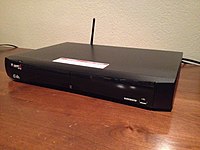Hopper (DVR)

Hopper with Sling box
|
|
| Developer | Dish Network |
|---|---|
| Manufacturer | Echostar |
| Type | Digital video recorder |
| Release date | March 2012 |
| System-on-chip used |
Broadcom 7420 Broadcom 7425 (Hopper with Sling) |
| Storage | 2 TB hard drive, expandable via eSATA |
| Connectivity |
Bluetooth, Coaxial cable, Ethernet Wi-Fi (Hopper with Sling only) |
| Website | dish |
Hopper is a line of digital video recording (DVR) set-top boxes offered by the U.S. direct-broadcast satellite television provider Dish Network. First introduced at Consumer Electronics Show in January 2012, the Hopper was released in March 2012 as a component of the provider's whole-home DVR system, which networks the main Hopper unit with smaller "Joey" set-top boxes to form a client-server architecture.
The Hopper is primarily distinguished by its "Primetime Anytime" functionality, which automatically records primetime programming off the four major U.S. television networks, while a later software update added "AutoHop", which allows commercials to automatically be removed from these recordings. The following year at the Consumer Electronics Show, Dish Network introduced an updated version known as Hopper with Sling, which integrates Slingbox place-shifting technology directly into the box.
Both versions of the Hopper were met with universal praise by technology publications, particularly surrounding its "PrimeTime Anytime" functionality, the AutoHop feature, integration with smartphones and tablets, and the addition of built-in place-shifting to its second iteration. However, despite the positive reception, the Hopper became the subject of a copyright lawsuit filed by major U.S. broadcasters shortly after its release, who questioned the legality of the AutoHop feature by considering it to be an attack on their business model. Although unsuccessful in its lawsuits against Dish Network, ABC (Disney), CBS and Fox Broadcasting Company have since used carriage agreements and other settlements to impose requirements for AutoHop to be disabled on their respective primetime programs for a period after their original air date.
...
Wikipedia
